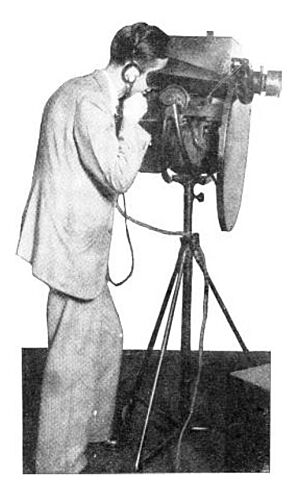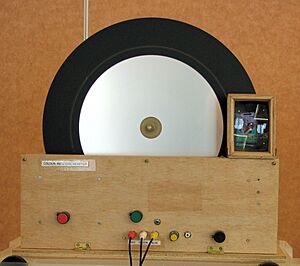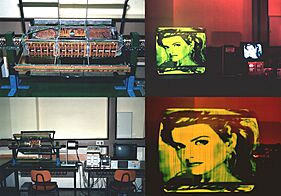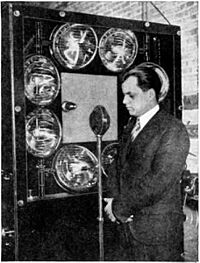Mechanical television facts for kids
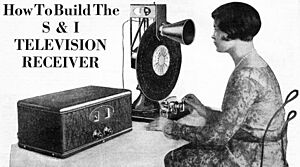
Mechanical television was an early type of television system. It used spinning parts, like disks with holes or rotating mirrors, to create and show pictures. Imagine a record player, but for images! This was very different from the vacuum tube electronic televisions that came later, which used electron beams to make pictures. Today, we use modern screens like liquid-crystal displays (LCDs) and LED displays for our TVs.
Mechanical television systems were used in the first experiments with TV in the 1920s and 1930s. One of the first wireless TV broadcasts was made by John Logie Baird in London on October 2, 1925. By 1928, many radio stations were trying out TV shows using these mechanical systems. However, the pictures were never clear enough to become popular with people. Electronic TV technology soon took over in the mid-1930s. This led to the first successful TV broadcasts in Great Britain. In the U.S., some stations, like W2XAB in New York City, started mechanical TV shows in 1931. But they stopped in 1933 and returned with electronic systems in 1939.
A mechanical television receiver was often called a televisor.
Contents
How Television Began
Early Ideas
The first ideas for scanning images mechanically came in the 1800s. This was for facsimile machines, which sent still pictures over wires. Alexander Bain created a fax machine in the 1840s. Later, Giovanni Caselli made a practical system for telegraph lines.
In 1873, Willoughby Smith found out that the element selenium could change electricity when light hit it. This led to the selenium cell, which was used in most mechanical TV systems to pick up light.
In 1885, Henry Sutton in Australia designed a device called a telephane. It used a spinning disk with holes, a selenium cell, and special light-bending parts to send images over telegraph wires.
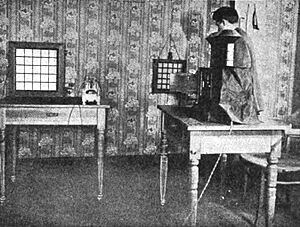
In 1909, a German scientist named Ernst Ruhmer showed the first "instant" transmission of images. He used 25 selenium cells to make a TV receiver. He successfully sent simple shapes over a telephone wire in Belgium. This was called "the world's first working model of television." But it was very expensive and could only show basic shapes.
Two French scientists, Georges Rignoux and A. Fournier, also worked on similar ideas. They used 64 selenium cells to create an "electronic eye." Their system could send individual letters of the alphabet.
In 1911, Boris Rosing and his student Vladimir Zworykin made a system that sent "very crude images" over wires. They used a mechanical scanner and a cathode-ray tube (CRT) for the display.
First TV Demonstrations
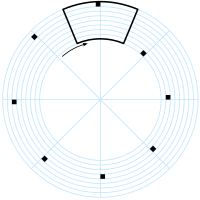
In 1884, a German student named Paul Julius Gottlieb Nipkow invented and patented the Nipkow disk. This spinning disk with a spiral of holes was a key part of most mechanical TV systems. It was used for both scanning the image and showing it.
The word television was first used by Constantin Perskyi in 1900. But it was the invention of the triode (an amplifying vacuum tube) by Lee de Forest in 1907 that made TV designs practical.
A Scottish inventor, John Logie Baird, built some of the first working TV systems in 1925. These used the Nipkow disk. On March 25, 1925, Baird showed moving silhouette images to the public in London. His system was too simple for human faces, so he used a dummy named "Stooky Bill" because its painted face had more contrast.
By January 26, 1926, Baird showed the first transmission of a moving human face by radio. This is seen as the world's first public TV demonstration. Baird's system used one Nipkow disk to scan the image and another to display it. Light from the subject hit a special cell that turned it into an electrical signal. This signal was sent by radio waves to a receiver. There, a neon light behind a second spinning disk recreated the picture. Baird's disk had 30 holes, making an image with only 30 lines. This was just enough to recognize a human face.
Baird continued to innovate. In 1927, he sent a signal over 438 miles (705 km) of telephone line. In 1928, his company sent the first TV signal across the Atlantic Ocean, from London to New York. By 1936, Baird's mechanical system reached 240 lines of resolution on BBC broadcasts.
An American inventor, Charles Francis Jenkins, also worked on television. In 1925, he publicly showed moving silhouette pictures. He used a Nipkow disk and sent the image of a toy windmill 5 miles (8 km) away.
On December 25, 1925, Kenjiro Takayanagi in Japan showed a TV system with 40 lines. It used a Nipkow disk and a CRT display. By 1927, he improved it to 100 lines. In 1928, he was the first to send human faces with different shades of gray.
On April 7, 1927, Herbert E. Ives and Frank Gray of Bell Telephone Laboratories gave an impressive demonstration. Their system could show clear, black-and-white moving images on both small (2 by 2.5 inches) and large (24 by 30 inches) screens. They also sent synchronized sound. The system sent images over both copper wires and radio links. Viewers saw no difference in quality. Even Secretary of Commerce Herbert Hoover was part of the telecast.
In 1928, General Electric (GE) started its own experimental TV station, W2XB, in New York. It was known as "WGY Television." This station later switched to an all-electronic system and is still broadcasting today as WRGB.
In the Soviet Union, Léon Theremin developed a mirror drum-based television. By 1927, he achieved a 100-line image.
Because mechanical systems used disks with a limited number of holes, the picture quality was usually low. It ranged from about 30 lines to around 120 lines. However, the quality of 30-line broadcasts got better over time. By 1933, UK broadcasts using the Baird system were quite clear. Some systems even reached 200 lines.
Color Television
In 1928, John Baird experimented with color television. Later, in 1940, Peter Carl Goldmark invented the CBS color television system. This system used a mechanical disk with color filters at the camera. At the TV receiver, a synchronized disk painted the same colors over the screen. As viewers watched through the color disk, the pictures appeared in full color.
Even after newer color systems came out, mechanical color methods were still used. For example, the cameras used on the Apollo Moon missions had color wheels. These cameras sent color TV pictures to Earth. Special equipment on Earth then converted these signals into standard color TV.
The End of Mechanical TV
The invention of vacuum tube electronic television changed everything. These new systems used image dissectors (camera tubes) and cathode ray tubes (CRTs) for displays. Mechanical TV usually made only small pictures and was the main type until the 1930s.
Electronic television, first shown by Philo Farnsworth in 1927, quickly became better than mechanical TV. Farnsworth's system was used for broadcasting in 1936, offering 400 to over 600 lines of resolution. In 1939, RCA bought Farnsworth's patents. RCA then started showing all-electronic television at the 1939 World's Fair in New York City. The last mechanical television broadcasts in the United States ended in 1939.
Scophony Mechanical Display
In 1938, a special mechanical TV receiver called 'Scophony' was made. It could show a 405-line picture (like the TV system used in the UK then) on a large screen, 24 inches wide and 20 inches high. There was even a version for theaters with a 6-foot wide screen! It used fast-spinning drums and a special cell to create the image from a bright light. While it produced impressive results, it was very expensive, costing twice as much as electronic TVs. It wasn't a big success, especially since TV broadcasts in the UK stopped during World War II.
Modern Uses of Mechanical Scanning
Since the 1970s, some amateur radio fans have experimented with mechanical systems. Today, bright LEDs replace the old neon lamps. There's interest in using these systems for narrow-bandwidth television. This would allow small or large moving images to fit into a much smaller radio channel.
Modern Digital Light Processing (DLP) projectors use tiny mirrors that move to create an image. Many DLP systems also use a color wheel to show colors one after another. This is similar to how early color TV systems worked.
Another place where mechanical scanning makes high-quality images is in laser printers. A small spinning mirror guides a laser beam to create the image on paper. Similar systems with powerful lasers are used in laser video projectors, like those in planetariums. These can create very high-quality video images.
Long-wave infrared cameras, used in military applications like night vision for fighter pilots, also use mechanical scanning. These cameras use rotating prisms to create standard video output. They are even used in sports to show where a ball hits a bat!
Laser lighting displays, combined with computers, are used in projects like LaserMAME. This system uses lasers and computer-controlled mirrors to draw images from classic arcade games.
How Mechanical TV Worked
Flying Spot Scanners
The most common way to create the video signal was with a "flying spot scanner." This was because early light sensors were not very sensitive. Instead of a camera taking pictures, a flying spot scanner shone a bright spot of light that quickly scanned across the scene in a dark studio. The light that bounced off the subject was picked up by many photoelectric cells. These cells turned the light into an electrical signal, which became the video signal.
The narrow light beam came from a lamp shining through the holes of a spinning Nipkow disk. Each time the spot moved across the scene, it created a "scan line" of the picture. A full picture, or "frame," usually had 24, 48, or 60 scan lines. The scene was scanned about 15 or 20 times per second. The changing brightness of the light spot as it moved across the subject created a changing electrical signal. To get enough signal, several photoelectric cells were used.
The BBC television service used the flying spot method until 1935. German television used it until 1938. One problem with flying spot cameras was that actors had to perform in near darkness. Also, they didn't work well outdoors in daylight.
In 1928, Ray Kell from General Electric showed that flying spot scanners could work outdoors. He used a 24-line camera to broadcast pictures of New York governor Al Smith. Smith was giving a speech outdoors. Kell managed to send usable pictures. However, when newsreel cameramen turned on their bright floodlights, Kell's scanner was overwhelmed. The floodlights made the whole scene too bright, and his sensors couldn't tell the difference between the scanned light and the general bright light. But in good conditions, his scanner worked well outdoors.
Bigger Pictures
Some mechanical TV systems could create images several feet or meters wide. These were as good as the early cathode ray tube (CRT) televisions that followed. CRTs at that time only had small, dim screens. One such system was developed by Ulises Armand Sanabria in Chicago. By 1934, Sanabria showed a projection system that made a 30-foot (9-meter) image.
The Scophony system, developed in the 1930s, was perhaps the best mechanical television. It could produce images with over 400 lines and display them on screens at least 9 by 12 feet (2.7 by 3.7 meters).
Picture Shapes
Some mechanical TV equipment scanned lines vertically instead of horizontally, like modern TVs. The Baird 30-line system is an example. Baird's British system made a picture that was a very narrow, vertical rectangle.
This created a "portrait" image, like a tall painting of a person. This is different from the "landscape" orientation (wider than tall) we see today. Baird's early images were very low quality, so a vertical image made sense to show one person clearly. He chose a shape that was three units wide by seven units high.
Baird might have thought of TV for one-on-one communication, like a video phone. The 1927 system by Herbert E. Ives at AT&T's Bell Laboratories also made a vertical "portrait" picture. Since AT&T wanted to use TV for phone calls, a vertical shape was logical for showing two people talking.
However, other inventors in the US, Germany, and elsewhere planned TV for entertainment. They started with square or "landscape" pictures. They realized TV was about showing groups of people. Soon, images grew to 60 lines or more, and cameras could easily photograph several people at once. Even Baird eventually switched to a horizontal image. For entertainment, landscape remains the most practical shape.
Recording TV Shows
In the early days of mechanical TV, a way to record images (but not sound) was developed. It used a modified record player. This system, called "Phonovision," was complicated and expensive. But it managed to save some early broadcast images that would have been lost forever.
A Scottish computer engineer, Donald F. McLean, has carefully rebuilt the old equipment needed to play these recordings. He has given talks about his collection of mechanical TV recordings made between 1925 and 1933.
Among Dr. McLean's collection are test recordings made by TV pioneer John Logie Baird himself. One disk from March 28, 1928, shows several minutes of a woman's face in what looks like a lively conversation. In 1993, the woman was identified as Mabel Pounsford. Her brief appearance on the disk is one of the earliest known video recordings of a human.
See also
- List of experimental television stations
- List of years in television
- Television systems before 1940
- Narrow-bandwidth television




